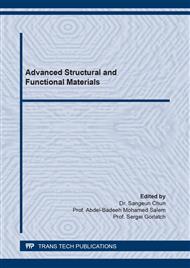[1]
F. Unal, F. Kaya, Modelling of relation between synthesis parameters and average crystallite size of Yb2O3 nanoparticles using Box-Behnken design, Ceram. Int. 46 (2020) 26800 - 26808.
DOI: 10.1016/j.ceramint.2020.07.155
Google Scholar
[2]
J. Yang, J. Shen, Q. Huang, Y. Guan, J. Miao, Hydrothermal synthesis and photoluminescence of host sensitized Yb2O3: Ho3+ nanorods, Mater. Res. Express. 6 (2018) 1.
DOI: 10.1088/2053-1591/aae75d
Google Scholar
[3]
M.S. Henriques, A.C. Ferreiraac, A. Cruza, L.M. Ferreiraa, J.B. Brancoa, P. Brazdab, K. Jurekb, T. Storad, A.P. Gonçalvesa, Preparation of Yb2O3 submicron and nano materials via electrospinning, Ceram. Int. 41 (2015) 10795 - 10802.
DOI: 10.1016/j.ceramint.2015.05.017
Google Scholar
[4]
H. Suo, C. Guo, L. Li, Host sensitized spherical up-conversion phosphor Yb2O3:Er3+, Ceram. Int. 41 (2015) 7017 – 7020.
DOI: 10.1016/j.ceramint.2015.02.005
Google Scholar
[5]
Y. Zheng, Q. Lü, J. Wang, G. Zhang, Y. Gao, Z. Liu, Emission behaviors of Yb2O3 nanoparticles pumped by 980 nm laser at different power densities, Opt. Laser Technol. 63 (2014) 39 - 44.
DOI: 10.1016/j.optlastec.2014.03.012
Google Scholar
[6]
S. Kumar, S. Chaudhary, G.R. Chaudhary, Modulating physicochemical properties in Gd3+@Yb2O3 nanospheres for efficient electrochemical monitoring of H2O2, Mater. Sci. Eng. C 114 (2020) 111059.
DOI: 10.1016/j.msec.2020.111059
Google Scholar
[7]
Z. Liu, Z. Li, J. Liu, S. Gu, Q. Yuan, J. Ren, X. Qu, Long-circulating Er3+-doped Yb2O3 up-conversion nanoparticle as an in vivo X-Ray CT imaging contrast agent, Biomaterials, 33 (2012) 6748 - 6757.
DOI: 10.1016/j.biomaterials.2012.06.033
Google Scholar
[8]
C. Qian, T. Zeng, H. Liu, Synthesis and downconversion emission property of Yb2O3: Eu3+ nanosheets and nanotubes, Adv. Condens. Matter Phys. (2013) 519869.
Google Scholar
[9]
S.S. Balabanov, D.A. Permin, E.Y. Rostokina, O.V. Palashov, I.L. Snetkov, Characterizations of REE:Tb2O3 Magneto-Optical Ceramics, Phys. Status Solidi Basic Res. 257 (2020) 1900474.
DOI: 10.1002/pssb.201900474
Google Scholar
[10]
A.K. Amin, K.R.E. Saraee, Synthesis and characterization of radio and thermoluminescence properties of Sm doped Gd2O3, Gd2O2S and Gd2O2SO4 nanocrystalline phosphors, J. Lumin. 220 (2020) 116979.
DOI: 10.1016/j.jlumin.2019.116979
Google Scholar
[11]
R.N. Maksimov, V.A. Shitov, V.V. Platonov, A.S. Yurovskikh, G. Toci, B. Patrizi, M. Vannini, A. Pirri, Hot isostatic pressing of transparent Yb3+-doped Lu2O3 ceramics for laser applications, Ceram. Int. (2020).
DOI: 10.1016/j.ceramint.2020.10.094
Google Scholar
[12]
A.A. Titov, N.P. Sokolova, M.V. Vorobeva, N.L. Opolchenova, Z.V. Eremenko, N.N. Stepareva, Synthesis and microstructure of nanocrystalline Yb2O3 powders, Inorg. Mater. 45 (2009) 884 - 888.
DOI: 10.1134/s0020168509080111
Google Scholar
[13]
X. Wang, Y. Li, Y. Zhou, Y. He, Application of a novel endocrine disruptor bisphenol A electrochemical sensor based on analogous heterostructure characteristics of La-doped Yb2O3 nanomaterials, Anal. Methods 11 (2019) 5613 - 5622.
DOI: 10.1039/c9ay01694e
Google Scholar
[14]
A. Konrad, T. Fries, A. Gahn, F. Kummer, U. Herr, R. Tidecks, K. Samwer, Nanocrystalline cubic Yttria: Synthesis and optical properties, Chem. Vap. Depos. 5 (1999) 207 -210.
DOI: 10.1002/(sici)1521-3862(199910)5:5<207::aid-cvde207>3.0.co;2-5
Google Scholar
[15]
E.E. Kaya, F. Unal, K. Kazmanli, S. Gurmen, Fabrication and characterization of Yb-doped Y2O3 powders and thin films, Int. J. Mater. Res., 7 (2020) 559 - 566.
Google Scholar
[16]
F. Unal, F. Kaya, K. Kazmanli, Effects of dopant rate and calcination parameters on photoluminescence emission of Y2O3 :Eu3+ phosphors : A statistical approach. Ceram. Int. 45 (2019) 17818 - 17825.
DOI: 10.1016/j.ceramint.2019.05.353
Google Scholar
[17]
X. Li, Z. Yang, L. Guan, J. Guo, Y. Wang, Q. Guo, Synthesis and luminescent properties of CaMoO4:Tb3+, R+ (Li+, Na+, K+), J. Alloys Compd. 478 (2009) 684 - 686.
DOI: 10.1016/j.jallcom.2008.11.109
Google Scholar
[18]
T. Tsuboi, S.M. Kaczmarek, G. Boulon, Spectral properties of Yb3+ ions in LiNbO3 single crystals: Influences of other rare-earth ions, OH- ions, and γ-irradiation. J. Alloys Compd. 380 (2004) 196 - 200.
DOI: 10.1016/j.jallcom.2004.03.043
Google Scholar


